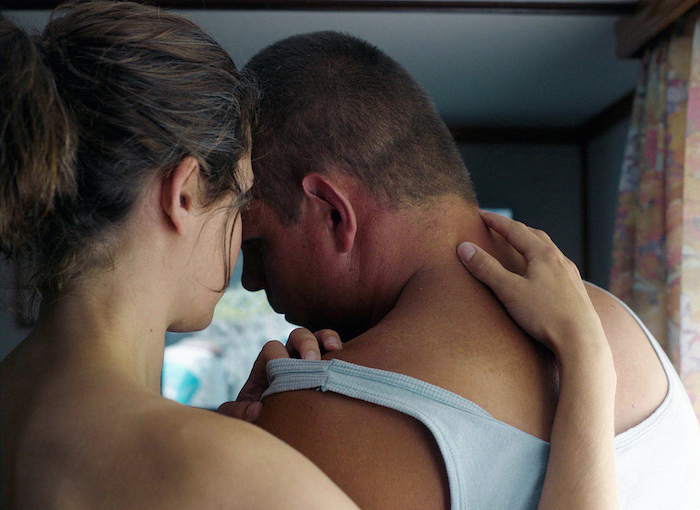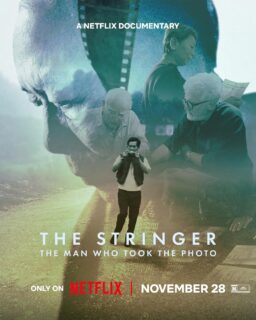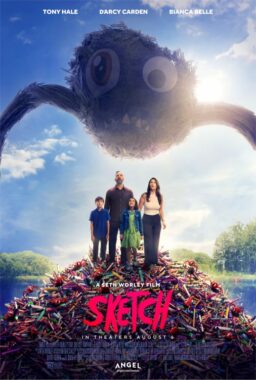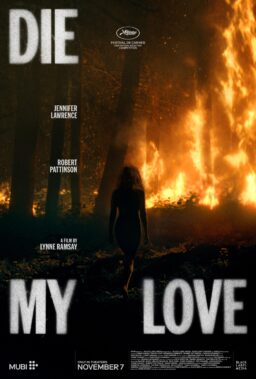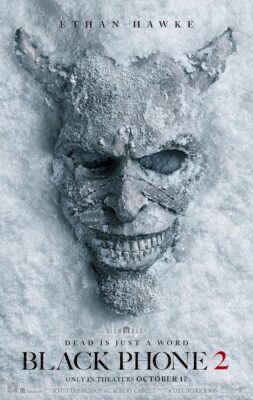Michael Koch’s “A Piece of Sky” is the kind of movie that spends a minute staring at a giant rock on a gorgeous mountainside, in order to teach you how to watch it. That very image is its first shot, as clouds move gently in the background, and it introduces Koch’s sensibilities as a budding filmmaker of pure slow cinema (Koch received one of this year’s two Roger Ebert New Director Awards at the festival). He is interested in studying people, places, things, and animals all at once. His images, and their free-flowing assembly, are enriched by this almost spiritual connectivity. You feel something for every particle on screen, even a giant rock.
The first human we meet is Marco (Simon Wisler), his massive back and shoulders complementing a silent presence. He bonds with the cows that he works with on a farm, including one named Freida. It is no diss to say that Marco is essentially a cow—moving along from one place to another, with the same gentle silence. When one of the cows that Marco is working with on the farm is taken to slaughter, it scares him like a premonition.
Marco is cared for by his new wife, Anna (Michèle Brand), who works at a restaurant/hotel hybrid, and also serves as a mailwoman for their small town. Care might be an understatement—she upholds him, she tries to make him a person. And she has no perfect compass herself, given the company she keeps with one of the restaurant’s patrons sometimes, in a worldview left unspoken. “A Piece of Sky” does not care about moralizing but presenting everything as it is.
One day, Marco gets into a motorcycle accident, which leads to a CT scan that detects a brain tumor. With just a few words, the doctor paints a picture of what’s next, including a lack of control on compulsions. Marco gets surgery, and we see a big scar on his head. He struggles to work, to have a purpose.
Marco, despite his hulking size, begins to minimize; now it is Anna’s shoulders that we follow behind through the spare snowy landscape, as she decides what actions are right with the burden that Marco has brought. The film does not romanticize the relationship, her choices, or even the polarizing empathy that makes for a striking third act. But the humanity does resonate in between the casually wondrous parts of this world: Koch gives us a long shot of bales of hay zip-lining through the clouds and crashing into the center of the frame, as if dropped from the sky.
Koch is restrained with music, but always makes you appreciate its presence. Haddaway’s “What is Love?” reverberates throughout the film, not just because it’s played twice as we see Marco and Anna in marital status—dancing at their wedding, and later driving, her hand on his shoulder—but because it doesn’t feel so out of place. Its title question is so sincere. And since there are so few rules in this story, Koch wields a slightly fantastical touch by bookending dramatic passages with a choir. Blocked with precision in the alpine landscape, they sing in immaculately framed wide shots in front of waterfalls or on a beach about a person’s downfall, and the afterlife.

With a performance of disquieting grace, Trace Lysette spends a lot of time in “Monica” watching other people. She is only a few feet away from them as they hug, talk, or share a general sense of worth, but it’s with an emotional distance that can damage one’s sense of self. Andrea Pallaoro’s brooding, compelling film firmly positions us in this point-of-view of feeling so removed.
Monica has returned home to help take care of her mother (Patricia Clarkson), who is suffering from a brain tumor. Monica has an added weight of not being recognized by her mother after transitioning but tries to use it as a way to say goodbye while being around her mother. Monica’s brother (Joshua Close) and sister-in-law (Emily Browning) have previously been taking care of her, along with Leticia (Adriana Barraza). The suffering has become a family affair, and Monica shakes up this world even more slightly by simply arriving.
Pallaoro and Orlando Tirado’s script exists in discomforting uncertainty, filled with a sense of fear. In an illustrative way, the film is a disturbing depiction of being afraid to face something that could be equally heartbreaking or nourishing, and not risking it. But we understand the complexities behind Monica’s actions thanks to Lysette’s restrained performance. Pallaoro invests a great deal on the precisions of her face, as with a long scene, shot in close-up, that has Monica driving away from her family, ready to leave it behind, before she turns around.
It’s the cinematography by Katelin Arizmendi (“Charm City Kings“) that provides the most depth to the script’s still waters. Adding to its austere pacing, the camera’s sensibilities love reflections, the way that Monica looking at a wall of picture frames can render her translucent—a ghost, a person not truly seen but only a bit of themselves. “Monica” is a wondrous work in terms of painting with light, in which the select shadows tell their own story. In the quiet spaces of Pallaoro’s film, we are left to search through Monica’s voluminous but unspoken feelings.

As part of their After Dark program, the festival held the Chicago premiere of Michelle Garza Cervera’s unsettling “Huesera.” Written by Cervera and Abia Castillo, “Huesera” becomes a poignant look at the fear of becoming a bad mother, with some earned jolts in the middle.
After a long time of trying—including prayer to religious icons, as seen in the opening shots—Valeria (Natalia Solían) has become pregnant. But she soon starts to have a swirl of anxieties, each made worse by visions that she sees, and that her husband Raúl (Alfonso Dosal) does not. First, Valeria sees a woman falling from a balcony to her death; later it’s someone breaking into their apartment after luring her outside. The evil forces are directly related to her growing worries, and the history of her being a harmfully bad babysitter that her family taunts her with.
Some of the film’s scares do not work, but the successful terror of the movie would not be complete without Solián’s performance as Valeria. She has the kind of expressive face that makes a moment even scarier, as when her wide eyes and mouth react to some freaky stuff off-camera. And like some of the best horror stories, “Huesera” gets extra creepy mileage from its sound mixing and design, which does well with making a queasy nightmare out of Valeria’s finger-cracking, for starters. “Huesera” is also freaky with its spider-like imagery, which ramps the film to a bizarre nightmare of a climax. Here’s hoping that “Huesera” is just the beginning for Cervera’s career about the anxieties that disturb us.

